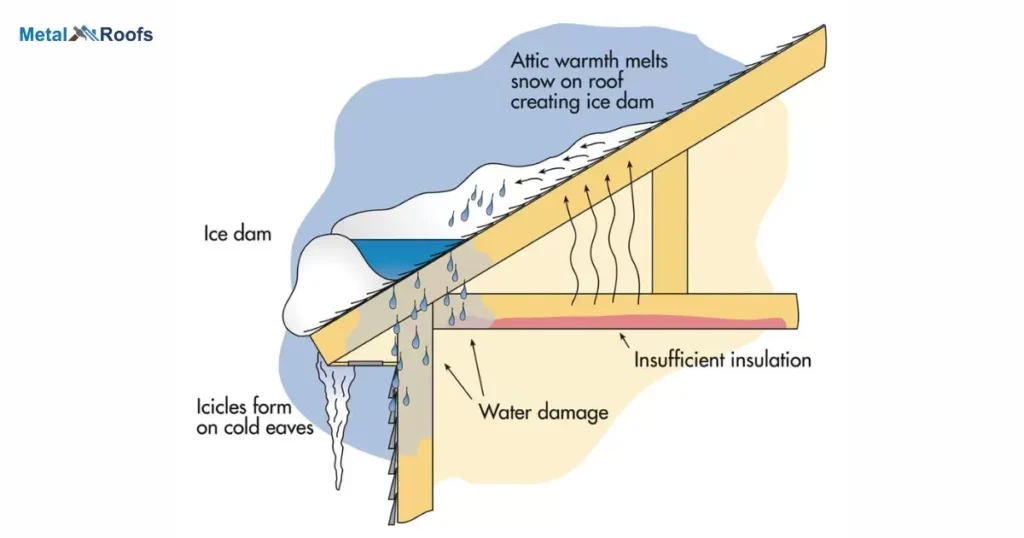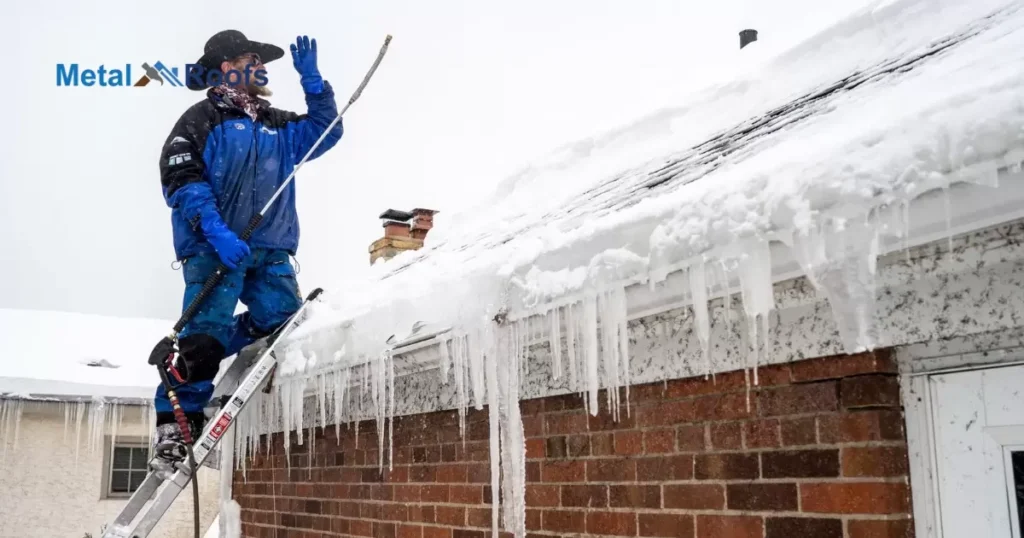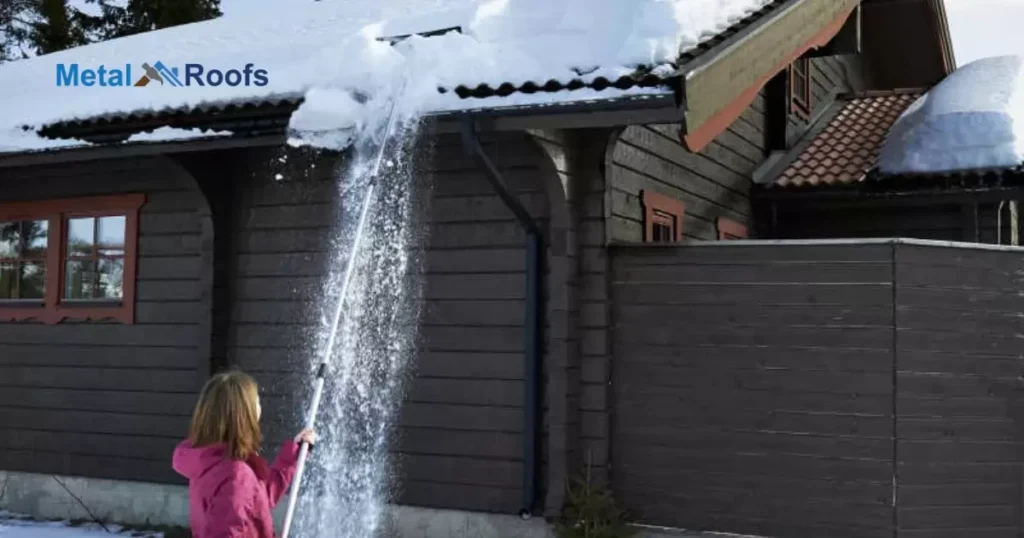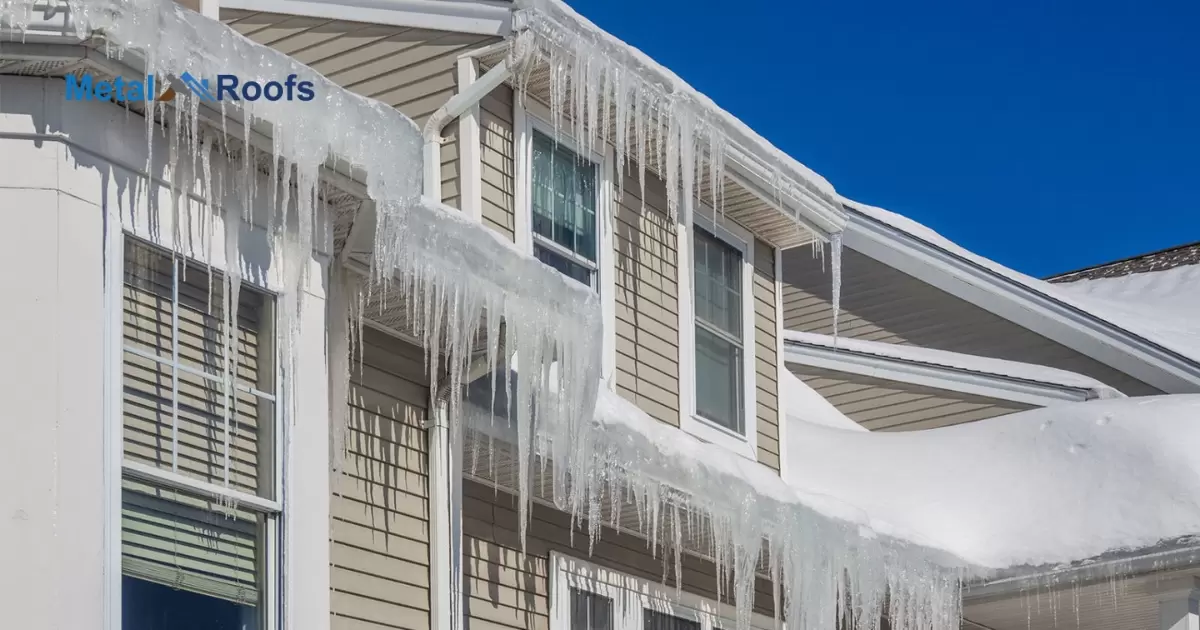Metal roofs lose heat faster which melts snow that runs down and refreezes at the edge creating ice dams that force water under shingles causing leaks; prevention includes sealing and insulating attic bypasses.
Metal roofs lose heat fast. Snow melts. Water runs down. It freezes at the edge. Ice dams form. They force water under shingles. This causes leaks. Understanding why helps prevent this. Do metal roofs get ice dams?
Metal roofs lose heat rapidly, leading to cold attics and melted snow. Refreezing at edges creates ice dams, causing leaks. Proper attic sealing is vital. Installing skylights through the attic can improve ventilation, mitigating ice dam risks.
Key Takeaways
- Ice dams trap water, forcing it to back up under shingles
- Backed up water can leak inside, causing interior water damage
- Prevent heat loss from attic by insulating and sealing bypasses
- Install underlayment barriers and use gutter guards as precautions
- Keep gutters clean after storms so water flows freely
- Take proper steps to protect metal roofs from ice dam water leaks
Problems Caused by Ice Damming

The moisture and weight from melting snow can create ice dams, which can damage your ceilings, gutters, and roof.
When a wall of ice forms, it blocks the meltwater from draining, causing it to pool and potentially leak into your house. These leaks can harm your home’s interior and lead to mildew and mold, which can cause respiratory issues.
Heavy ice and snow buildup can also cause parts of your roof to collapse, posing a future risk. There’s also a danger of injury from falling ice dams.
Some people have even died from falling icicles. To avoid serious injury or property damage, homeowners should take steps to prevent ice dams. One effective measure is installing metal roofing.
What are Ice Dams on Metal Roofing?
Ice dams on metal roofing happen when snow melts on the warmer upper part of the roof and freezes at the colder eaves. This occurs due to heat escaping from inside the building. Metal roofs are less prone, but still, ice dams can form under specific conditions.
Insufficient insulation, poor ventilation, or uneven roof temperatures can contribute to their formation. Proper attic insulation and ventilation are essential to prevent ice dams. Installing snow guards along the eaves helps slow down snow sliding, reducing the risk of ice dams. Regular roof maintenance in winter can catch issues early and prevent ice dams.
How Do Ice Dams Affect Metal Roofing?
| Effect of Ice Dams on Metal Roofing | Description |
| Potential Leakage | Ice dams can cause water to backup under metal panels, leading to leaks into the attic or interior of the home. |
| Structural Damage | The weight of ice dams can put stress on the roof structure, potentially leading to damage or even collapse, although metal roofs are generally more resistant. |
Ice dams can trouble metal roofs when warm air escapes into the attic, melting snow on the roof. As melted snow flows down, it freezes again at the eaves, forming ice dams. Metal roofs are generally less prone to ice dams but can still suffer if not properly insulated and ventilated.
Insufficient insulation and ventilation can lead to inconsistent roof temperatures, fostering ice dam formation. Installing snow guards along the eaves helps prevent sudden snow slides, reducing the risk of ice dams. Regular roof maintenance during winter can catch issues early and prevent ice dams from causing damage.
Preventing Ice Dams on Metal Roofing

To prevent ice dams on metal roofing, start by ensuring proper insulation and ventilation in the attic. Check for any gaps or leaks that could let warm air escape. Install snow guards along the eaves to prevent snow from sliding off all at once. Regularly monitor the roof during winter for any signs of ice dam formation and address any issues promptly.
Metal roof ice stops
Metal roofs sometimes get ice dams. But ice stops can help. They prevent snow from sliding down all at once. Just install them strategically along the roof’s edge. They’ll hold the snow, preventing it from forming dangerous ice dams.
A Metal Roof Is Not 100% Ice-Dam Proof?
While metal roofs are less prone to ice dams, they’re not completely immune. Factors like roof features and local climate can lead to ice buildup. Proper insulation and ventilation help minimize risks. Regular maintenance and monitoring are still essential for prevention.
Roof and Gutter De-Icing Systems for Metal Roofing
Metal roofs can sometimes face ice dams in colder climates. To tackle this, roof and gutter de-icing systems come into play. These systems typically involve heating cables installed along the roof edges and in gutters.
The cables melt snow and ice, preventing the formation of dams. They’re especially useful in areas where ice build-up poses a risk. Regular maintenance and proper installation of these systems are crucial for effectiveness.
Benefits of Using Roof and Gutter Heat Trace on Metal Roofing
Using roof and gutter heat trace on metal roofing systems offers several benefits, especially in cold climates or areas prone to ice and snow buildup. Here are some of the key advantages.
Prevents Ice Dams: Ice dams form when snow on the roof melts and refreezes at the eaves, creating a barrier that prevents proper drainage. Heat trace systems can help prevent ice dams by ensuring that the snow and ice on the roof melt and drain away properly.
Prevents Roof Damage: The weight of accumulated snow and ice can put stress on a roof, especially a metal roof. Heat trace systems help prevent this buildup, reducing the risk of roof damage or collapse.
Prevents Water Damage: Ice dams can cause water to back up under shingles or metal panels, leading to water leaks and damage to the roof structure, insulation, and interior of the building. Preventing ice dams, heat trace systems help protect against water damage.
Improves Safety: Icy roofs and gutters pose a safety hazard for people walking below, as well as for those tasked with clearing snow and ice from the roof. Heat trace systems help keep roofs and gutters clear of ice and snow, reducing the risk of accidents.
Preserves Energy Efficiency: Ice and snow buildup on roofs can act as insulation, reducing the effectiveness of the building’s insulation and increasing heating costs. Preventing ice dams and ensuring proper drainage, heat trace systems help maintain the energy efficiency of the building.
Extends Roof Lifespan: The repeated freeze-thaw cycles associated with ice dams can cause damage to roofing materials over time. Preventing ice dams and reducing the stress on the roof, heat trace systems can help extend the lifespan of the roof.
Maintains Curb Appeal: Ice dams and icicles hanging from the roof can detract from the appearance of a building. Heat trace systems help keep roofs and gutters clear of ice and snow, preserving the aesthetic appeal of the property.
Overall, the use of roof and gutter heat trace on metal roofing provides a cost-effective solution to prevent ice and snow-related damage while improving safety and energy efficiency.
Metal Roof Ice Problems
Metal roofs generally resist ice dams, thanks to their smooth surface. Yet, certain conditions can still lead to problems. Factors like roof features and local climate influence ice buildup. Proper installation and maintenance are crucial.
Ensure adequate insulation and ventilation to minimize risks. Regular inspections help identify potential issues early. Installing snow guards or heating cables can prevent ice dams. Stay vigilant to protect your metal roof from ice problems.
Ice Belt Metal Panels
Ice Belt Metal Panels are designed to combat ice dams on roofs. Their smooth surface helps snow slide off easily, reducing the risk of ice dams forming. Proper installation is crucial to maximize effectiveness. Ensure adequate insulation and ventilation to prevent ice buildup.
Regular maintenance helps identify and address potential issues early. In colder climates, additional measures like snow guards or heating cables may be necessary. Stay proactive to protect your roof from winter’s icy grip.
How To Remove Ice Dam From Metal Roof?

To remove ice dams from a metal roof, first, use a roof rake to gently remove snow from the edge of the roof. Next, fill a pantyhose or sock with calcium chloride ice melt and place it perpendicular to the ice dam. Then, let it sit on the ice dam, allowing the calcium chloride to melt through the ice.
After some time, the ice should start to melt and create a channel for water to flow off the roof. Once the ice dam has melted sufficiently, use a roof shovel to carefully remove any remaining ice and debris from the roof’s surface. To prioritize safety when removing ice dams and consider hiring a professional if the task seems too challenging.
Frequently Asked Questions
Do metal roofs need ice breakers?
Metal roofs generally don’t require ice breakers because they’re less prone to ice dams. In certain situations with valleys or dormers, ice dams can still form.
How do you remove ice from a metal roof?
To remove ice from a metal roof, clear loose snow, sprinkle calcium chloride, and gently break up remaining ice with a plastic shovel.
Do you need ice and water under metal roof?
Yes, you need ice and water shield under a metal roof. It provides extra protection against leaks. The shield prevents water from seeping into your home during heavy rain or if ice dams form.
Conclusion
Metal roofs lose heat fast. Attics get very cold. Snow melts on the warm roof. Water runs down and refreezes. Ice dams form at the edges. Prevent heat loss from the attic. Insulate and seal bypasses. This will reduce ice dams.
Install water barriers under shingles. Use drip edge and gutter guards. Keep gutters clean after storms. Moving water won’t back up and leak. Take steps to prevent ice dams on metal roofs. Protect your home from water damage.











